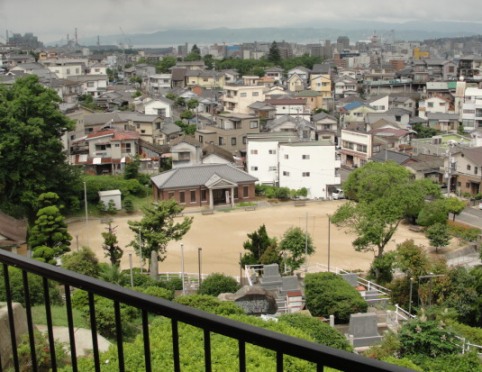Battleship Yamato War Dead Monument
Kure City, Hiroshima Prefecture
The Imperial Japanese Navy established a cemetery in Kure in 1890. After the
war the national government maintained this former naval cemetery until it was
transferred to Kure City in 1986. The former cemetery is now part of Nagasako
Park, which includes about 90 monuments erected after the end of World War II in
order to remember men who died in battle. The park still has 169 graves from
before the end of the war.
The Battleship Yamato War Dead Monument was erected at Nagasako Park in 1979 on April 7, the
34th anniversary of the ship's sinking. Yamato, the world's largest
battleship, was built nearby at Kure Naval Arsenal and was commissioned on
December 16,1941. The monument is the first one seen by Nagasako Park visitors.
On April 6, 1945, Yamato led a fleet
of ten ships toward Okinawa on a tokkō (special attack) mission. Yamato
and five other ships were sunk the next day by numerous torpedoes and bombs
dropped by American planes.
Several bronze plaques around the wall at the back and sides of the
Battleship Yamato War Dead Monument list the names of over 3,000 men aboard Yamato
who died in battle when the ship sank on April 7, 1945. The names of the
war dead are
organized by the men's home prefectures. A plaque on the wall to the left of the
monument summarizes Yamato's battle history as translated below:
Battleship Yamato War Record
November 4, 1937 - keel laid down at Kure Naval Arsenal as Battleship No.
1
August 8, 1940 - launched
December 8, 1941 - outbreak of Greater East Asia War
December 16, 1941 - commissioned and hoisted military flag, sailed to
Hashirajima, assigned to Combined Fleet's Battleship Division 1 (main unit)
February 12, 1942 - after becoming flagship of Combined Fleet Commander in
Chief Yamamoto, served in main unit for Midway Operations and supported
Guadalcanal Operations, mainly anchored at Truk Island
February 11, 1943 - flagship changed to Musashi, became Ship 2 of
Battleship Division 1
June 27, 1943 - supported all operations as central part of Combined Fleet
December 25, 1943 - hit by torpedo from U.S. submarine between Yokosuka and
Truk Island during emergency transport operations of 4,000 emergency troop
reinforcements for Guadalcanal Island
February 25, 1944 - assigned to Unit 1 of Second Fleet Battleship Division 1
commanded by Vice Admiral Matome Ugaki
May 11, 1944 - departed Lingga anchorage to participate in "Operation A"
June 19-20, 1944 - participated in Battle of Philippine Sea
June 24, 1944 - returned to Hashirajima by way of Nakagusuku Bay, Okinawa
July 16, 1944 - proceeded to Lingga anchorage and carried out training for
decisive battle
October 18, 1944 - made sortie from Lingga anchorage to start Sho Operation
No. 1
October 23-26, 1944 - participated in Second Battle of the Philippine Sea
(Kurita fleet flagship, Ugaki battleship division flagship)
November 20, 1944 - returned to Kure
March 19, 1945 - fought at Hiroshima Bay with American carrier-based planes
April 5, 1945 - start of Kikusui Operation No. 1
April 6, 1945 - departed toward Okinawa as flagship of tokkō (special
attack) fleet under command of Vice Admiral Seiichi Ito
April 7, 1945 - sank at 2:23 p.m. after fighting fiercely for more than 2
hours with 386 aircraft from American high-speed carriers
The base of the Battleship Yamato War Dead Monument has a photograph of the
ship.

Photograph of battleship Yamato on monument base
A plaque on the wall at the left side of the monument summarizes key facts
about the battleship Yamato as translated below:
Battleship Yamato Ship History
Keel laid down - November 4, 1937
Launched - August 8, 1940
Commissioned - December 16, 1941
Principal Facts
Crew Members: 3,000 men
Length: 263 meters
Widest Breadth: 38.9 meters
Total Displacement: 72,809 tons
Speed: 27.46 knots
Cruising Range: 3,500 nautical miles at 27 knots, 10,000 nautical miles at
16 knots
Armament Main Facts
Main Guns: 3 triple turrets with 45-caliber 46-cm guns (9 guns) with
range of 41,400 meters
Secondary Guns: 2 triple turrets with 15.5-cm guns (6 guns)
Antiaircraft Guns: 12 twin mounts with 12.7-cm guns (24 guns)
Machine Guns: triple mounts with 25-mm guns (102 guns), 48 13-mm guns
Aircraft: 6 reconnaissance and observation seaplanes
Catapults: 2
Radar: 5 sets
Hydrophone: 1 set
Transponder: 1 set
Rangefinders: 4 15-m rangefinders, 1 10-m rangefinder, 2 8-m rangefinders
Searchlights: 6 150-cm searchlights

View of Kure City from hill at Nagasako Park
(park monuments in foreground
and Kure Harbor in background)
A scene from the 2005 Japanese movie Otokotachi no Yamato (Men's
Yamato) takes place at the Battleship Yamato War Dead Monument in Nagasako
Park.
Kure City also has the Yamato Museum
and Battleship Yamato Monument.
|